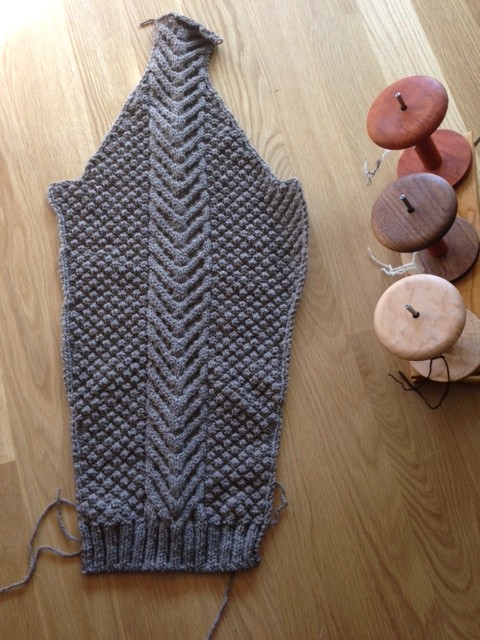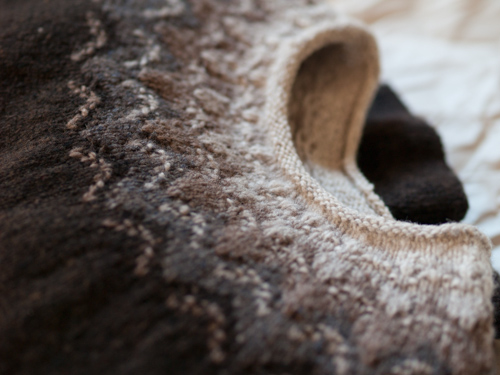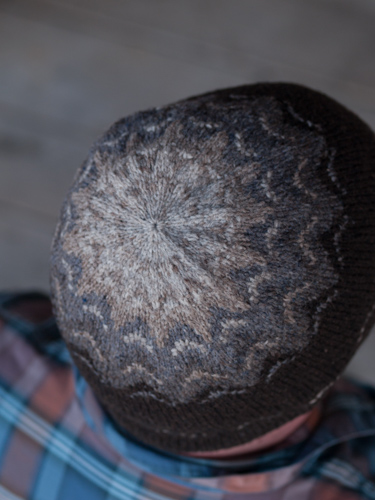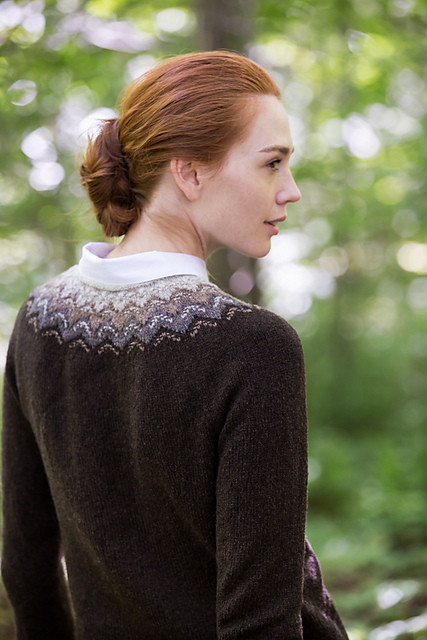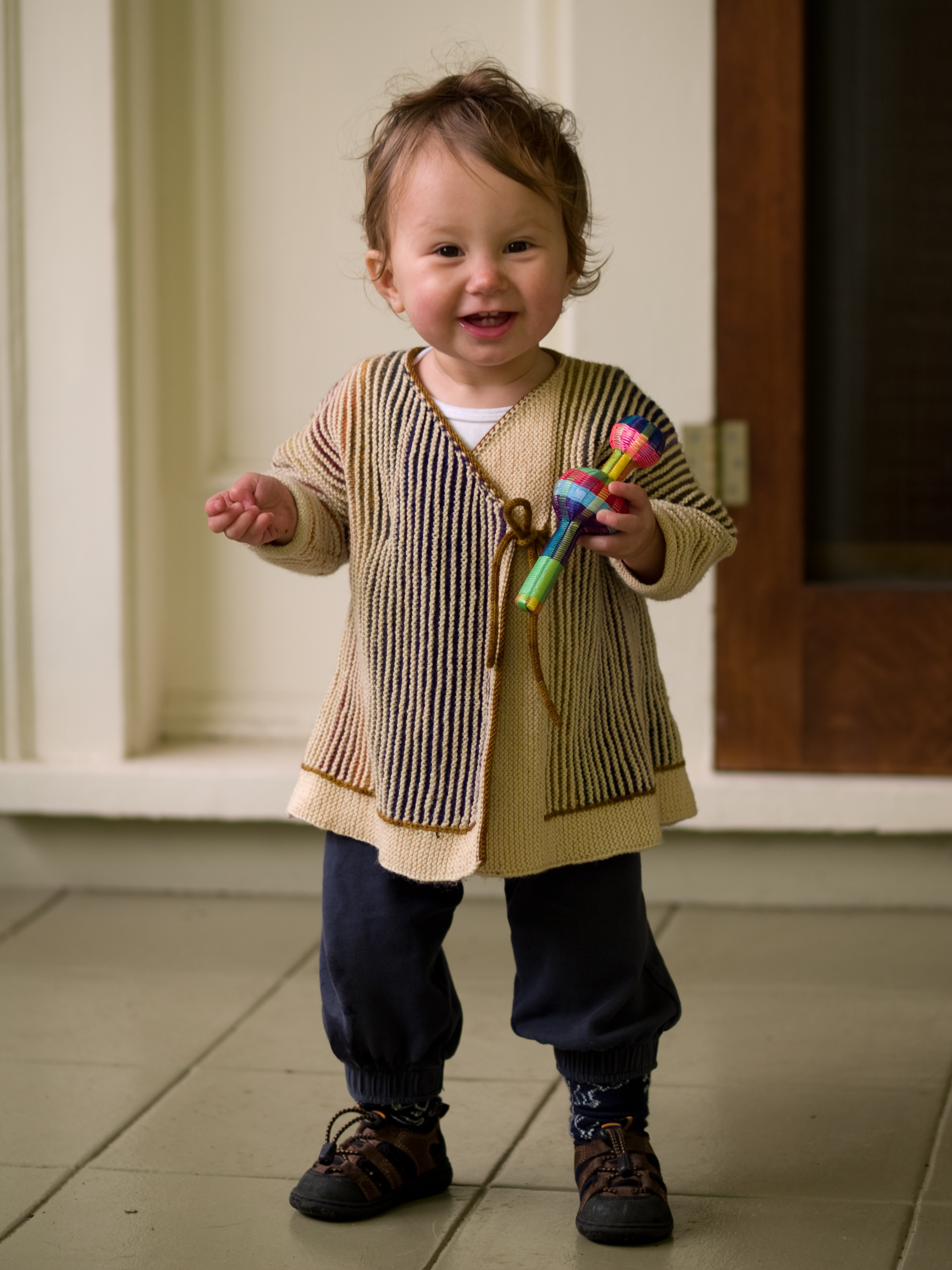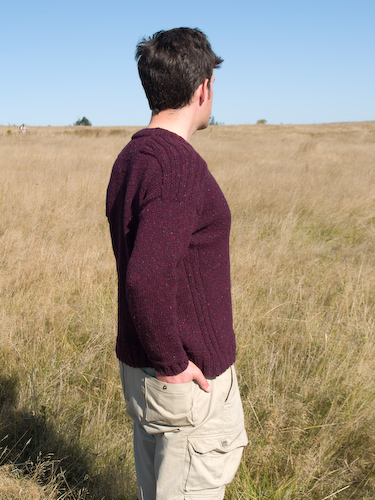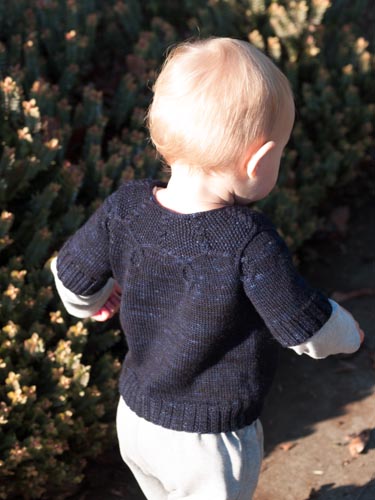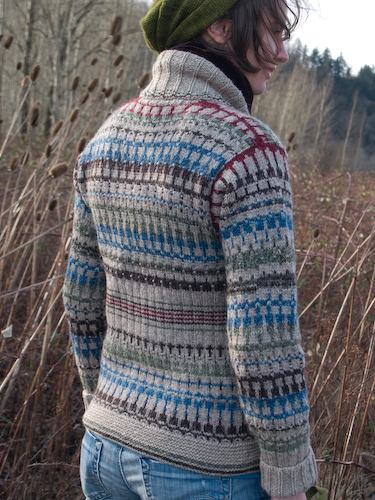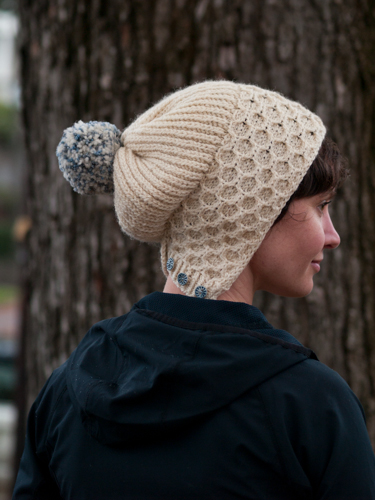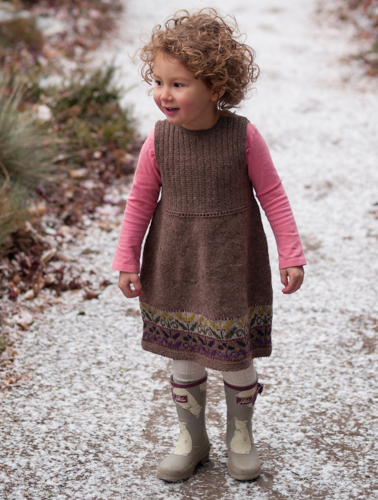I feel guilty writing it when New England friends can’t see out their ground-floor windows, but the Northwest appears to have given winter a miss and gone straight on to spring. The tulips bulbs Ada and I planted in the November rain are thrusting up furled mauve leaves and the daffodils have been in full bloom since last week. The robins have started to sing. It’s impossible to feel truly resentful while bathed in sunshine, but it’s been a pathetically short knitting season. (Knitting is always in season, if you ask me, but I relish the kind of winter weather that makes knitting seem like the only practical activity. When the outdoors are truly inviting, there are so many more activities that compete with the wool and needles.) I’ve got many a wooly sweater on the needles and I fear I’ll be putting them straight into storage for at least six months.
One piece I’ve been especially wanting to tell you about is Michele Wang’s beautiful Cordova pullover. This pattern came out just as I acquired a sweater’s worth of Elsa Wool Company Cormo, and the two things were fused in my brain in less time than it takes to type it. I knew I had to check my gauge over both the staghorn cables and the trinity stitch, so it seemed like an entirely practical move to simply cast on a sleeve. Not, however, as directed—with a tubular CO and a couple of inches of ribbing. The cuff wasn’t going to help my sleeve-as-swatch.
So I cast on provisionally and jumped straight into the main motifs above the cuff. This is one of my very favorite knitting tricks. I used it with Pomander when I was knitting from the bottom up and wanted to complete the yoke before working the sleeves. With my short-sleeved version, I knew I’d be running out of yarn; finishing the yoke and buttons bands and weighing the remnant before picking up stitches and working the sleevelets downward let me use every last yard. I use a waste yarn provisional CO because it’s the fastest, requires no extra tools (am I the only one who can never lay hands on a crochet hook when it’s needed?), and is the only one I can remember off the top of my head. This time I took it a step further and used a spare cable from my interchangeable set in place of the waste yarn. Being stiff, it was a little more awkward for the first couple of rows than waste yarn would have been, but I was feeling so clever about being able to simple screw on a pair of tips and work in the opposite direction to finish the ribbing that I didn’t mind. Also, by working the cuff downward, I’d be able to do a tubular bind-off instead of the laborious tubular cast-on. Since I don’t mind grafting in the slightest, this is a much less time-consuming maneuver for me.
I used the recommended US #9 needles and quickly had a chunk of sleeve long enough to serve as a gauge swatch for Cordova. I loved the fabric I was getting with the Elsa Wool. I took my wooden tips off the cable and pitched the whole thing into the sink for a soak. (If I’d been using fixed metal needles, I’d have chucked them in, too.) The fabric dried beautifully. I checked my gauge. It did not, sadly, match what the pattern required. Knitting protocol dictates that you switch needle sizes at this point and try again. But here’s the rub: my gauge was off by a different amount over the staghorn cable and over the trinity stitch. Switching needles couldn’t entirely solve the problem. And I liked the fabric—I didn’t want to go up a needle size anyway. So I took a different approach: I did some simple math.
I firmly believe that a knitter must not fear mathematics. No fear, people! I mean it: you’ll be so much happier with your garments if you can just cast back past the trauma of Algebra II and reel in a couple of basic mathematical operations to serve you as you plan a new project. I’m speaking from experience. (Besides wanting to improve my knitting, I had no choice but to overcome my math anxiety, since there were those five ironic years when my job required me to collaborate on a trilogy of algebra books.)
Ratios have turned out to be one of my most useful tools when I’m grading a pattern for sizes; I do everything in percentages so I can retain or alter the proportions of a design element as necessary. I’ve thought about sweaters this way since my first introduction to Elizabeth Zimmermann’s EPS—Elizabeth’s Percentage System, which you can find in any of her books. (And here’s a link to a Knitty article that walks you through the whole process if you want to make an EPS sweater.) While I often want to adjust the numbers EZ settled on for stylistic reasons, the relationship between elements of the sweater are still the key to a good fit. So I measured my Cordova sleeve/swatch and compared it to the target pattern gauge in terms of percentages.
If you want to try this, divide the gauge the pattern demands by the gauge you actually got. In my case, the pattern wants 21.5 st/4″ in trinity stitch, but I had 24.25 st/4″. So I divided: 21.5/24.25 = 0.887, which means I’m going to end up with a sweater 89% of the size it ought to be. Uh-oh! My gauge over the large staghorn cable was closer: 92% of the target. But still too small. So the next step is to look at the pattern and see what happens if you follow directions for a different size. I’d intended to knit the 37″ size; the next step up is 40.25″. Taking a rough average of my two different gauges, what’s 90% of 40.25″? 40.25 x 0.9 is 36.225″. If I follow the 40.25″ directions, my sweater will be between 36″ and 37″ in circumference, which is darn close to the size I set out to knit in the first place. Huzzah!
It’s equally important to check row gauge, of course. A lot of patterns are written for linear measurements: you change patterns after 2.5″, begin shaping when piece measures 5.5″ from CO edge, etc. But rates of increase or decrease will still throw you if your row gauge is off, and in my experience it’s much more difficult to match another knitter’s row gauge than stitch gauge. Weirdly, although my stitch gauge for Cordova was much too small, my row gauge was larger than the target gauge. I’m not sure this has ever happened to me, and it was a real warning flag. I was beginning with a sleeve. I had a certain number of increases to accomplish within a fixed distance. If I’d had more rows per 4″ than the target gauge, it wouldn’t have much mattered. My increases would have been finished early, but I could have gone on knitting plain until I reached the proper length; no blood, no foul. But it was taking me fewer rows to reach 4″ than the pattern specified, and that meant there was every likelihood I’d reach the 17.5″ of sleeve to the armhole without having made it wide enough yet. So I needed to increase more quickly. I had a bit of leeway because I was already planning to add about 1″ to the sleeve length to adjust for my height. But I had a strong sense of foreboding that 1″ wouldn’t be enough extra runway. The pattern directs me to increase every 8th row; I reckoned it would be safer to make it every 6th row. I could have been more scientific about this, but I made a gut-instinct adjustment and went with it. (And it worked perfectly. Lucky me.)
I wasn’t out of the woods yet, though. This is a photo of Sleeve the First, which I’ve since ripped and mostly reknit. Can you see why?
Yep, there’s something fishy about the comparative width of the two trinity panels beginning halfway up. (Trinity stitch is the nubbly textured part on either side of the cable.) And that’s because I flubbed keeping the pattern correct over a changing stitch count on the right edge. Trinity stitch is made by gathering in trios of stitches while tripling their next-door neighbors. Every increase maneuver has to be paired with a corresponding decrease, so you have to view the stitches on your needles in clusters of four. As your sleeve is widening, it’s very tempting to work a decrease or an increase as soon as you’ve added enough stitches to accomplish it, but you must resist until you have added all four of the new stitches you need to work both a new decrease and a new increase. I learned the hard way that the best way to check whether you should work one more trinity increase or decrease is to look at the edge that isn’t expanding or contracting, the edge near the cable. If the final move at that edge of the panel is going to be a decrease, there had better be an increase as the first move at the other edge. And vice versa. Otherwise you’re going to change the stitch count and increase or decrease too quickly. (This sleeve cap took me three tries for the same reason. Learning curve!)
Glad to report that Sleeve the Second went perfectly, once I’d sussed out the properties of trinity stitch fabric. And while I’m this deep in Knitting World, I’m also going to tell you that Cormo wool is maybe the most amazing substance on the planet. This Elsa Wool is so soft, so incredibly pleasing to knit. The woolen-spun prep makes it faintly rustic and nubbly, like Shelter, and like Shelter the stitches really cohere after blocking, but it’s got a bit more twist so I think it will wear a little harder. This will not be my last sweater from this yarn. Although I am swearing an oath not to buy any more natural sheep shades for awhile. I seem to be knitting nothing but grey and brown for myself, and there are two more sweaters quantities of natural white and palest grey on deck. Must inject a bit of color into the wardrobe! Maybe I should sew something bright to pair with all these neutrals? At least there’s no chance I’ll camouflage with my environs. Not with spring going off like fireworks all over town.
